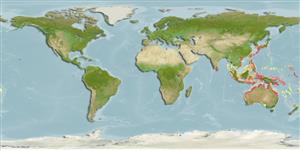Environment: milieu / climate zone / depth range / distribution range
Ecologia
marinhas; Água doce; estuarina bentopelágico; anfídromo; intervalo de profundidade 0 - 5 m (Ref. 86942). Tropical; 20°C - 28°C (Ref. 13614)
Indo-West Pacific: Sulawesi, Indonesia to western and eastern Australia and New Caledonia.
Tamanho / Peso / Idade
Maturity: Lm ? range ? - ? cm
Max length : 40.0 cm SL macho/indeterminado; (Ref. 48637)
Espinhos dorsais (total) : 7 - 12; Raios dorsais (total) : 16; Espinhos anais: 4; Raios anais : 15 - 16. Greenish or silvery; individuals greater than 4 cm SL with 7 to 12 narrow dark vertical bars on dorsal half of flanks and with spots, usually smaller than eye, more or less arranged in vertical rows in ventral half; lips black; posterior edge of caudal fin and soft portions of anal and dorsal fins with a narrow black margin which disappear in individuals larger than 6 cm SL (Ref. 43044).
Found in coastal estuaries, river entrances and rock pools (Ref. 9002, 44894). Inhabits mangrove creeks and the lower reaches of freshwater streams (Ref. 44894). Anterolateral glandular groove with venom gland (Ref. 57406). Sometimes sold fresh in markets (Ref. 43044). Juveniles collected for the aquarium trade (Ref. 43044).
Ciclo de vida ou comportamento de acasalamento
Maturidade | Reprodução | Desova | Ovos | Fecundidade | Larvas
Kottelat, M., 2001. Scatophagidae. Scats. p. 3623-3626. In K.E. Carpenter and V. Niem (eds.) FAO species identification guide for fishery purposes. The living marine resources of the Western Central Pacific. Vol. 6. Bony fishes part 4 (Labridae to Latimeriidae), estuarine crocodiles. FAO, Rome. (Ref. 43044)
Status na Lista Vermelha da UICN (Ref. 130435: Version 2024-2)
Uso pelos humanos
Pescarias: pouco comercial; Aquário: Espécies comerciais
Ferramentas
Relatórios especiais
Baixar XML
Fontes da internet
Estimates based on models
Preferred temperature (Ref.
123201): 21.4 - 29.3, mean 28.4 °C (based on 2076 cells).
Índice de diversidade filogenética (Ref.
82804): PD
50 = 0.8125 [Uniqueness, from 0.5 = low to 2.0 = high].
Bayesian length-weight: a=0.02570 (0.01005 - 0.06572), b=2.96 (2.75 - 3.17), in cm total length, based on LWR estimates for this (Sub)family-body shape (Ref.
93245).
Nível Trófico (Ref.
69278): 2.9 ±0.3 se; based on size and trophs of closest relatives
Resiliência (Ref.
120179): Elevada, tempo mínimo de duplicação da população menor que 15 meses (Preliminary K or Fecundity.).
Fishing Vulnerability (Ref.
59153): Moderate vulnerability (39 of 100).
